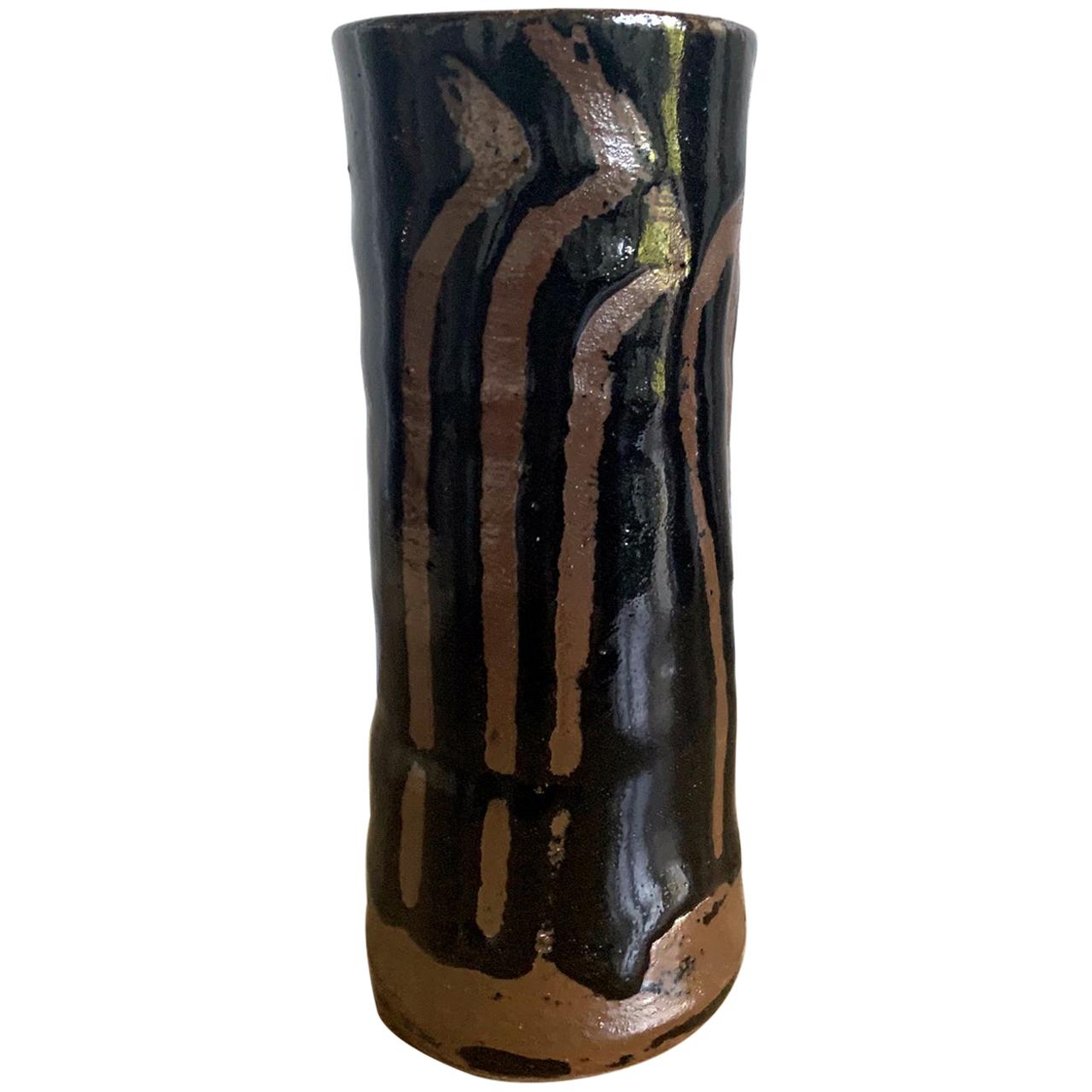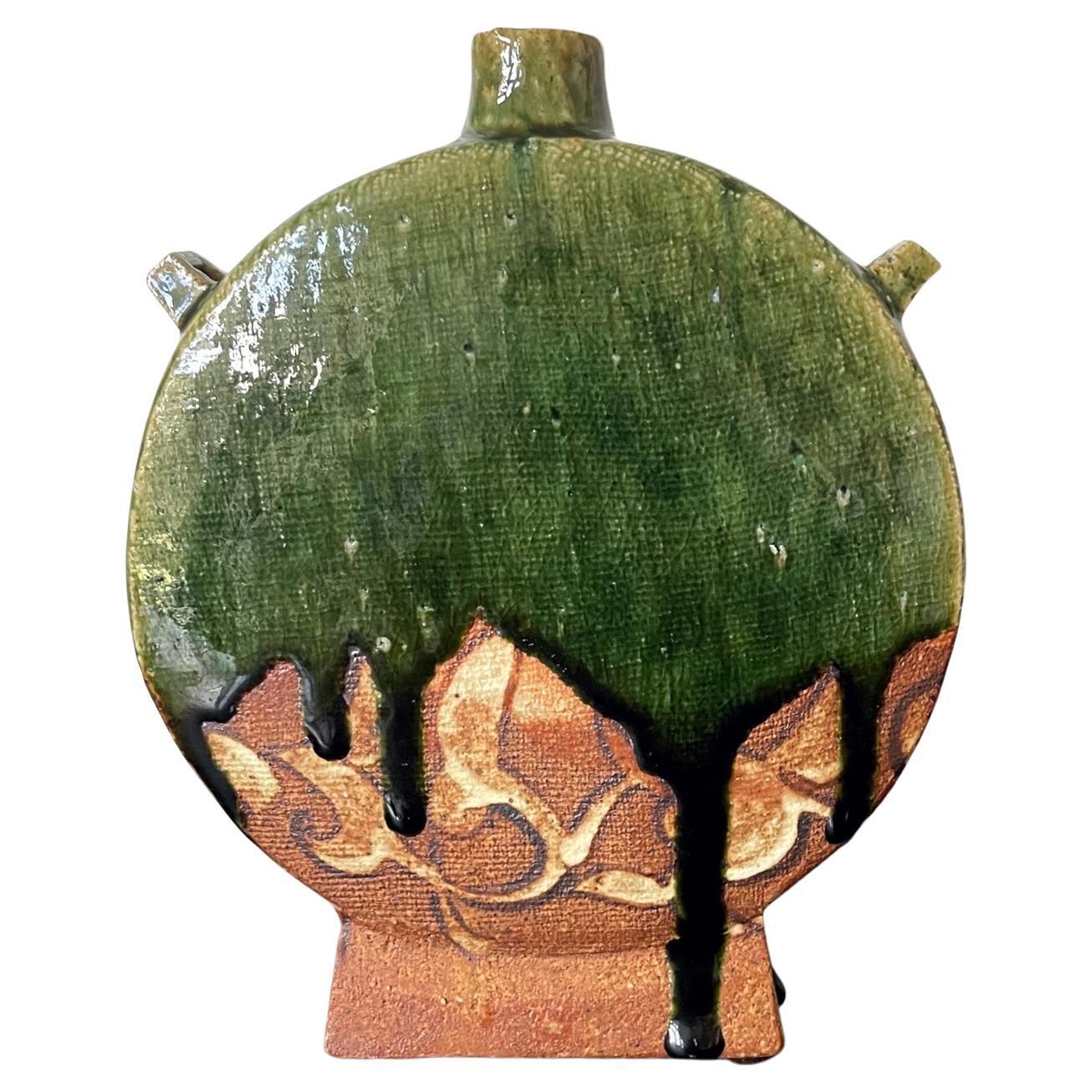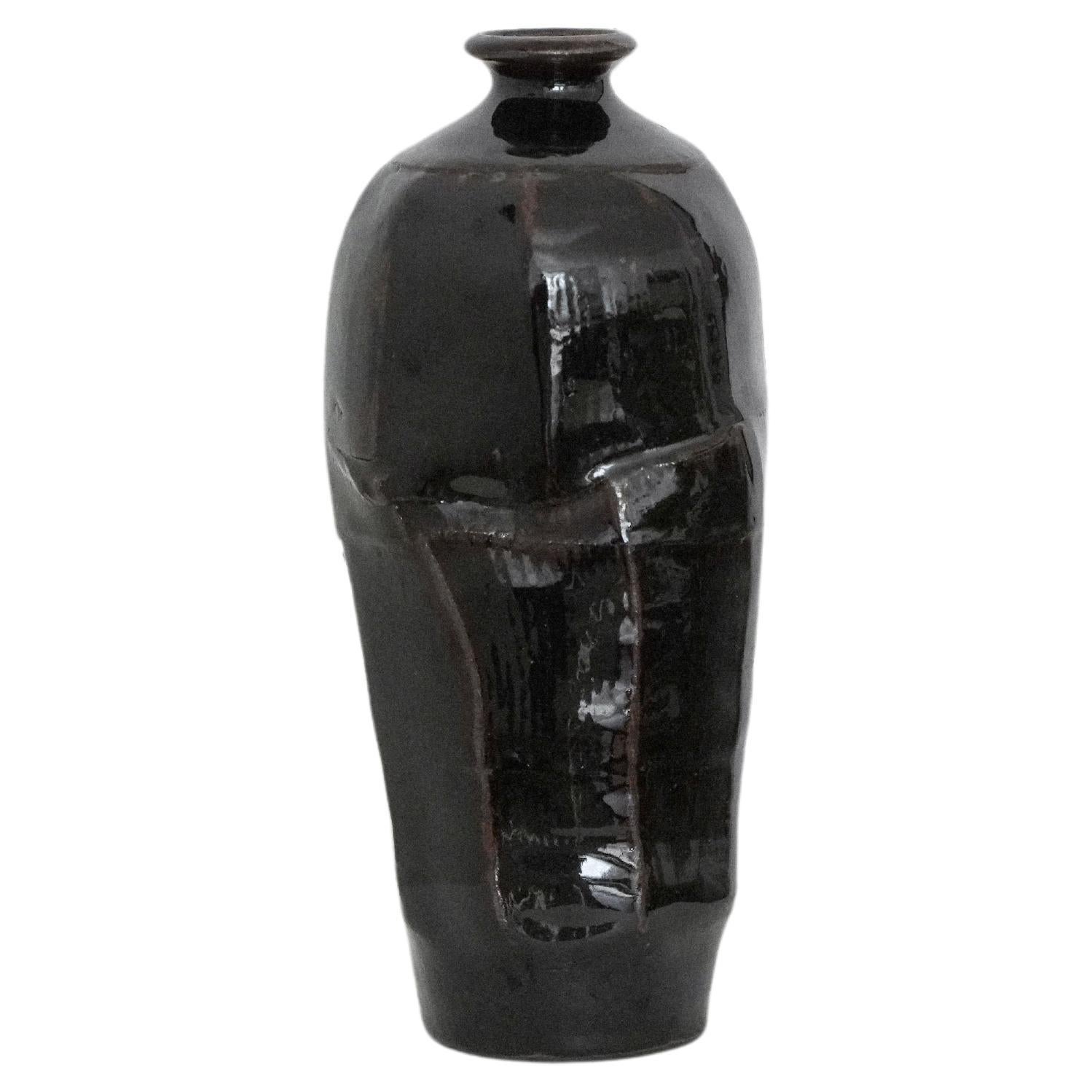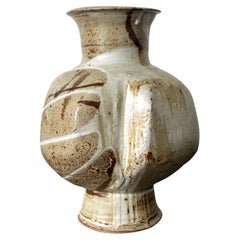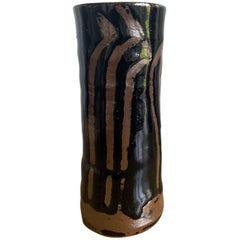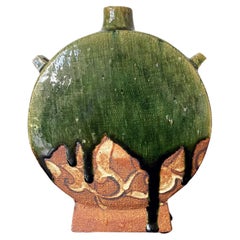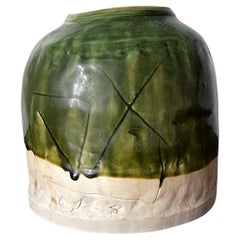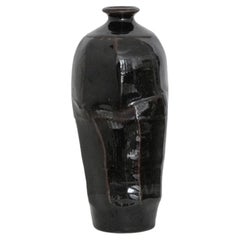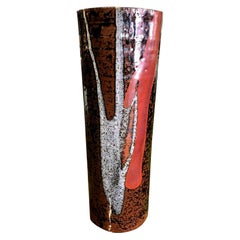Items Similar to Japanese Studio Ceramic Vase by Ken Matsuzaki with Original Tomobako
Want more images or videos?
Request additional images or videos from the seller
1 of 19
Japanese Studio Ceramic Vase by Ken Matsuzaki with Original Tomobako
$8,000
£6,116.43
€7,044.89
CA$11,210.45
A$12,515.42
CHF 6,557.89
MX$153,200.98
NOK 83,285.27
SEK 78,527.43
DKK 52,576.72
About the Item
An impressive stoneware bottle form vase by contemporary Japanese studio potter Ken Matsuzaki (1950-) circa 2010s. The solid form takes its cue from Chinese traditional plum vase (Meiping) with raised and swelled shoulder and a small opening, yet it rises from a non-conventional pentagonal faceted base. The extraordinary surface was covered with Yohen Shino glaze in a deep iron hue. Thick white slips were applied in bold strokes to the lower portion of the vase. The abstract pattern calls to mind of the imagery of the iconic ocean waves found in traditional Japanese art. The presence of the vase is strong and none-compromising, reaching back to the past yet appearing utterly modern. It is marked by the artist underneath and comes with the original tomobako with title and author inscriptions and a wrapping cloth with the artist's seal.
"Ken Matsuzaki’s haptic ceramics bring a contemporary approach to traditional Japanese ceramicware, most notably 16th-century Oribe pottery. His irregular vessels, tea bowls, and sake cups reflect the artist’s singular process of kiln firing combined with more than two decades of experience on the wheel and in dynamic handbuilding. Matsuzaki has exhibited widely in Japan; he gained a greater international profile after his inclusion in a 2003 exhibition at the Metropolitan Museum of Art that explored the lasting influence of Oribe. Since 1977, Matsuzaki has worked at his studio in Mashiko, where he built the unique anagama wood-fired kiln that produces the expressive glaze effects for which he is known. Inspired by the philosophy of the Mingei movement—which privileged “ordinary people’s crafts”—Matsuzaki’s ceramics are the results of a humble and painstaking approach. His works are in such collections as the Art Institute of Chicago; the Museum of Fine Arts, Boston; and the Asian Art Museum of San Francisco" (Courtesy of Artsy).
- Creator:Ken Matsuzaki (Artist)
- Dimensions:Height: 13.5 in (34.29 cm)Diameter: 8.25 in (20.96 cm)
- Style:Modern (Of the Period)
- Materials and Techniques:Ceramic,Glazed
- Place of Origin:
- Period:
- Date of Manufacture:2010s
- Condition:Wear consistent with age and use. Minimal if any wear. With original tomobako and wrapping cloth with inscription and seal.
- Seller Location:Atlanta, GA
- Reference Number:1stDibs: LU945028662582
About the Seller
4.9
Platinum Seller
Premium sellers with a 4.7+ rating and 24-hour response times
Established in 2006
1stDibs seller since 2010
565 sales on 1stDibs
Typical response time: <1 hour
- ShippingRetrieving quote...Shipping from: Atlanta, GA
- Return Policy
Authenticity Guarantee
In the unlikely event there’s an issue with an item’s authenticity, contact us within 1 year for a full refund. DetailsMoney-Back Guarantee
If your item is not as described, is damaged in transit, or does not arrive, contact us within 7 days for a full refund. Details24-Hour Cancellation
You have a 24-hour grace period in which to reconsider your purchase, with no questions asked.Vetted Professional Sellers
Our world-class sellers must adhere to strict standards for service and quality, maintaining the integrity of our listings.Price-Match Guarantee
If you find that a seller listed the same item for a lower price elsewhere, we’ll match it.Trusted Global Delivery
Our best-in-class carrier network provides specialized shipping options worldwide, including custom delivery.More From This Seller
View AllCeramic Vase with Bespoken Glaze by Makoto Yabe
By Makoto Yabe
Located in Atlanta, GA
Made by Japanese ceramic artist Makoto Yabe (1947-2005), this stoneware vase features a globular body supported by a round pedestal foot. A similarly shaped neck extends to a rimmed mouth opening. Robust in form with thick wall, the vase is noted for its irregular cloved form. The surface is covered in a beige-yellow glaze, on top of which, dark brown strokes and thick white feldspar slip were artistically applied in a splashed and washed pattern. Together with some random shallow incision lines, they form an abstract painting with textured surface where some slip forms small droplets at the end of the stroke. The work was created in traditional Japanese manner and reflects the beauty of Wabi Sabi, a Zen aesthetic for the imperfect perfection.
The base was incised with the artist's cipher.
"Makoto Yabe's work beautifully exemplifies the transmission of Japanese ceramics to the West. Born in Fukushima, Japan, Yabe began studying ceramics in Kyoto at the age of nine. He completed his training at the age of 24, with a four-year apprenticeship under Jinmatsu Uno and Sango Uno. Yabe then came to Boston, where he was an integral member of the local ceramic community, yet he maintained his Japanese roots. As an instructor of ceramics, Yabe worked in the Boston area at numerous schools and universities, touching the lives of all his students and expanding their knowledge and appreciation of studio ceramics."
Biography sited from Pucker Gallery...
Category
Late 20th Century American Organic Modern Ceramics
Materials
Ceramic, Stoneware
Japanese Ceramic Vase Mingei Style Hamada Shoji
By Hamada Shoji
Located in Atlanta, GA
A heavily potted stoneware vase in cylindrical form, decorated with abstract strokes in iron rust glaze (known as Persimmon Glaze in Japanese) on a black glazed background. The pattern suggests autumn grasses, and it was applied with free hands. The vase is attributed to Japanese potter Hamada Shoji...
Category
Late 20th Century Japanese Arts and Crafts Ceramics
Materials
Ceramic
Modern Japanese Studio Pottery Oribe Moon Flask Vase by Ken Matsuzaki
By Ken Matsuzaki
Located in Atlanta, GA
A contemporary studio ceramic vase made by Japanese potter Ken Matsuzaki (1950-). The vase showcases distinguished "moon flask" form with shoulder loops. The moon flask form was widely recorded first in Tang Dynasty China, most likely arrived from the Mideast countries via the silk road. It was originally used as drink vessel for the nomads and the loops were used to tie it to the horse-centered owner. The exotic form persisted in Chinese ceramic production through Ming to Qing dynasty. The form is unusual in Ken Matsuzaki's work. The artist covered the vase with a thick dripping Oribe green glaze partially revealing the unglazed part of the body, which is decorated with scrolling pattern in left by ash glaze. The work is rooted in both Yohen Shino glaze technique and Oribe tradition, but interestingly it also paid homage to Sancai pottery in Tang Dynasty when green glaze was prominently used to drip and splash onto the pottery. Viewing the vase, one can see in this harmonious piece, the innovative reinterpretation of ancient aesthetics that cross the cultures, geology and time. The base is marked with the artist's signature. The vase comes with an inscribed tomobako storage box with the artist's bio and wrapping cloth with seal. The vase measures 8.6"h x 7"w x 2"d.
Ken Matsuzaki’s haptic ceramics bring a contemporary approach to traditional Japanese ceramicware, most notably 16th-century Oribe pottery...
Category
Early 2000s Japanese Modern Ceramics
Materials
Ceramic
Japanese Modern Studio Ceramic Oribe Jar by Ryoji Koie
By Ryoji Koie
Located in Atlanta, GA
A glazed ceramic vessel by Japanese potter Ryoji Koie (1938-2020). Hand-built with intention to be seen as such, the tsubo has a primordial irregular form with a small opening and a swelled body resembling a beehive. The upper body was covered in a glassy green oribe glaze with fine crackles, highlighted with three incised geometrical symbols. The lower body is unglazed and exposed the white clay with marks of the hand-making pinches and kneading along the base. The base also shows highly irregular surface due to the seashell spur marks and clay pitting in the kiln during the firing process. All these occurrences honestly preserved and presented as part of the character of this wonderful modern piece. The jar comes with a plain wooden tomobako box.
"One of Japan’s most versatile and forward-thinking contemporary artists, KOIE RYOJI...
Category
21st Century and Contemporary Japanese Modern Ceramics
Materials
Ceramic
Asian Flambe Studio Pottery Vase
By Kyoto Pottery
Located in Atlanta, GA
A garlic bottle vase in an archaic Chinese form, but likely Japanese in origin. Several circumventing grooves however, suggest a more modern age. It was done in a brilliant purple glaze over a robin egg blue background glaze. The bubbling and bursting effects during the firing renders the surface an artistic spotting effect. The color pallet recalls the Classic Jun Yao...
Category
Antique Late 19th Century Japanese Japonisme Ceramics
Materials
Ceramic
Large Japanese Ceramic Oribe Sculptural Vessel by Shigemasa Higashida
Located in Atlanta, GA
A large ceramic lidded vessel with striking sculptural form by contemporary Japanese potter Shigemasa Higashida (1955-). Hand-built and with drasti...
Category
Early 2000s Japanese Modern Ceramics
Materials
Ceramic
You May Also Like
Japanese Sumida Gawa ceramic vase
By Sumida Gawa
Located in Autonomous City Buenos Aires, CABA
Sumida Gawa Japanese ceramic vase
Sumida Gawa Japanese ceramic vase decorated in relief with three ladies, two of whom are servants, with a lattice in the centre and an iridescent ef...
Category
20th Century Japanese Japonisme Vases
Materials
Ceramic
Sculptural Vase with Tenmoku Glaze
Located in Watford, GB
Sculptural handmade vase with dark brown Japanese Tenmoku glaze by a London-based potter.
Category
21st Century and Contemporary British Anglo-Japanese Vases
Materials
Ceramic
Bicone Vase by U-Turn Ushiro
Located in Sammu-shi, Chiba
Bicone vase by U-Turn Ushiro.
It is baked for several days in an anagama (a kiln that burns firewood).
It is shaped vertically symmetrically. The copper contained in the clay blows out on the surface, and reddish-black spots can be seen partially. It is a work where you can see various reactions of various ingredients.
U-Turn Ushiro
While working at the fire station...
Category
2010s Japanese Japonisme Ceramics
Materials
Pottery
Japanese Midcentury Large Glazed Pottery Vase in the Manner of Shoji Hamada
Located in Studio City, CA
A really large and wonderful piece. Clearly, the maker was a fan of Shoji Hamada's work. Could be a Mashiko Ware pottery vase.
Signed on the base along with a sticker on the insi...
Category
Vintage 1960s Japanese Showa Ceramics
Materials
Earthenware
Ceramic Vase by Edgardo Abbozzo
By Edgardo Abbozzo
Located in New York, NY
Ceramic Vase by Edgardo Abbozzo, Italy, 1965.
In the early 1970s Edgardo Abbozzo assumed the role of director of the Art Institute of Florence and in 1973, after having obtained the ...
Category
Mid-20th Century Italian Mid-Century Modern Vases
Materials
Ceramic
Ceramic Vase by Tim Keenan
By Tim Keenan
Located in Washington, DC
Beautiful ceramic vase by Tim Keenan. Condition is excellent. Signature to underside. Measures 10.25"H x 6"D.
Category
21st Century and Contemporary Vases
Materials
Ceramic
More Ways To Browse
Kiln Japanese
Abstract Japanese Ceramics
Japanese Art Ocean
Japanese Studio Pottery
Studio Pottery 21st Century
16th Century Japanese
Plum Vase
Chinese Studio Pottery
16th Century Chinese Ceramics
Japanese Sake
Iron Chinese Vase
Japanese Ceramic Cups
Japanese Ceramics Mingei
Meiping Vase
Sake Bottle
Chinese Meiping
Chinese Meiping Vase
Sake Cup

